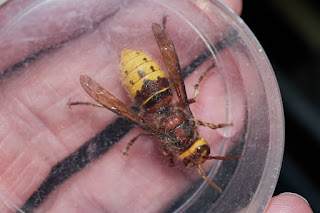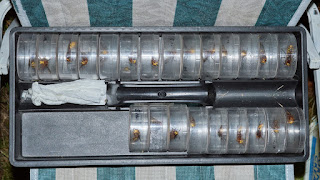Wednesday 23rd August 2023, Hurst Wood, All Stretton
Hurst Wood is a house in All Stretton with a large garden surrounded by extensive grassland and woodland, with a few small quarries thrown in for good measure.
We were met by the owner who gave us a brief history of the house and the work necessary to build it.
After a quick look around the garden bordering the driveway where we had parked, we made our way to the first area of grassland to the west of the house which, in turn, led to a sizeable area of oak woodland.
The gatekeeper, a Green shieldbug nymph, very kindly granted us access.
We dispersed to follow our interests, some staying in the grassland, others climbing the hill to investigate the oak woodland beyond the summit ridge and others doing both!
A centipede was beaten from the vegetation in the grassland. Centipedes are not normally animals that we identify, but this was an “easy” one as it had variegated appendages as implied in its name – Lithobius variegatus.
Meanwhile, on one of the many oaks, an Oak bush cricket was spotted.
 |
| Photograph: David Williams |
This was soon followed by a Forest bug.
 |
| Photograph: David Williams |
Having told you that we had made our way the grassland I noticed that one of the group had gone off on his own and was investigating conifers on the other side of the track that led to the house. Here he found a larva of a Barred red moth in some conifers.
 |
| Photograph: Graham Wenman |
Continuing to look at the grassland vegetation we were rewarded with the sight of a long-horn beetle, Rutpela maculata on a thistle.
 |
| Photograph: David Williams |
After a while, as I was searching the trees that formed the edge of the grassland, I noticed that several of the group had congregated on the opposite side. As it was too early for lunch I assumed that something out of the ordinary had been found. And this is what it was:
 |
| Photograph: David Williams |
A rather impressive red and black beetle with “netted” wings, Platycis minutus. Its name does not reflect its size as it is not minute, being about 7mm in length.
A further find at this time was the larva of a Pale tussock moth.
 |
| Photograph: David Williams |
Our woodland explorers returned. And they were bearing gifts – two ladybirds:
 |
| Photograph: David Williams |
A 10-spot ladybird on the lower left of the above photograph and a Cream-spot ladybird on the upper right.
They had also found a fly, Dilophus bispinosus.
 |
| Photograph: Nigel Jones |
This is a scarce fly with very few UK records, and it was the first time that it had been recorded in Shropshire.
This was an excellent find.
As we had all magically gathered and it was time for lunch we made our way back to the house to enjoy our picnics.
At the house we were greeted by our hosts who provided us with copious amounts of tea and coffee, and…
CAKE
Even better...
TWO CAKES!
Some of us were very disciplined and ate our lunches first. Others dived straight in.
I can report that the Coffee and Walnut cake was excellent. It was very hard to resist having a second slice, but I did.
Where we had lunch at the side of the house provided an excellent view across the valley and of Caer Caradoc on the far side.
Lunch over we waddled into the garden and grassland to the east of the house.
An early find in a Scot’s pine that bordered the garden was an 18-spot ladybird.
 |
| Photograph: David Williams |
And in another Scot’s pine, in the grassland, we located a Striped ladybird. I believe that this is only the second time that the group has found this species.
 |
| Photograph: David Williams |
At some stage during the day, I am not sure when, a White-line dart was spotted and photographed.
 |
| Photograph: Neil Nash |
The star of the flora on site was a collection of spikes of Greater broomrape. This plant is a parasite of Broom and Gorse and some other shrubs - there was plenty of Broom and some Gorse nearby.
Unfortunately, no-one has sent me a photograph of the plant to include so we will have to make do with my photograph of some Orpine found on the slope.
 |
Thank you to our hosts for their very warm welcome and excellent refreshments. My gratitude to the photographers for their images that illuminate this tale.
Wednesday 30th August 2023, Llynclys Common
I was unable to attend this outing as I was away assisting a house move and I have received few words about what happened during the day.
But, do not despair, I have been sent plenty of photographs.
I start with the major news. THREE new species of fly for the county were found on the day:
Acinia corniculata, a rarity and a very pretty fly with mottled wings;
 |
| Photograph: Nigel Jones |
Philygria interstincta, a tiny fly found in a suction sample; and
Chlorops rufinus, another found by suction sampling. This is quite a scarce species and is associated with calcareous habitats, which seems appropriate for this site.
 |
| Photograph: Nigel Jones |
Despite being far, far away, I was asked to suggest a route.
I did.
It would take the group through woodland, a meadow, quarries, limestone pavement and other choice habitats.
Did they follow my suggestion?
I have no idea.
But from the photographs I know they visited the quarries.
Without further ado here are some photographs of what was found somewhere on the site roughly in the order they were found based on the time the photograph was taken.
A Leafmine on a Cow parsley leaf caused by the nymph of the fly, Phytomyza chaerophylli.
 |
| Photograph: John Lyden |
A Dock bug.
 |
| Photograph: David Williams |
A couple of sawfly larva munching their way through leaves on a rose bush, identified as the Large rose sawfly, Arge pagana.
.jpg) |
| Photograph: David Williams |
A hoverfly, Dasysyrphus tricinctus.
 |
| Photograph: David Williams |
A bumble bee worker, either Bombus lucorum or terrestris (the workers are indistinguishable).
 |
| Photograph: David Williams |
A fungus, Blackening waxcap.
 |
| Photograph: John Lyden |
A gall on a rose bush caused by the gall wasp Diplolepsis rosae. Fortunately we do not need to remember this name as it is knows as a Robin’s pin cushion.
 |
| Photograph: John Lyden |
We are now into the afternoon and in, I believe, one of the quarries known as Lower and Upper Butchers Quarry.
A Syrphus hoverfly on Devil’s-bit scabious.
 |
| Photograph: David Williams |
Another hoverfly, Ferdinandea cuprea also on Devil’s-bit scabious.
 |
| Photograph: John Lyden |
The bank of Devil’s-bit scabious where the two hoverflies may have been found.
 |
| Photograph: Nigel Jones |
A female Migrant hawker dragonfly.
 |
| Photograph: David Williams |
Another dragonfly, this time a Southern hawker.
 |
| Photograph: John Lyden |
A Green shieldbug.
A pair of Spiked shieldbugs doing what comes naturally.
 |
| Photograph: David Williams |
A large tachinid fly, Tachina fera.
 |
| Photograph: David Williams |
And after a large fly a small ladybird, Nephus redtenbacheri.
 |
| Photograph: David Williams |
Thank you to Shropshire Wildlife Trust for giving us permission to enjoy ourselves and to the photographers for their images.
Other News
Sunday 20th August 2023, Withybed Wood, Wyre Forest
A gathering of the Shropshire Spider Group and friends visited the Withybed Wood region of the Wyre Forest.
There were a number of spiders that our leader wanted to see including the Green huntsman and Strawberry spiders.
Unfortunately, he was only partially satisfied as we found several Green huntsman but no Strawberries.
Still we had an excellent day which included a brief encounter with an Adder.
OK, an Adder is not a spider, but we did not confine ourselves just to spiders.
Here are some photographs from the day.
A woodland dor beetle. These are a bit of a hazard as you wander around the wood as they tend to be found on paths and it is difficult to avoid treading on them.
 |
| Photograph: Nigel Cane-Honeysett |
A spider, Misumena vatia. This spider is able to change its colour to blend in with its background while it waits for suitable prey to wander close enough for it to capture.
 |
| Photograph: Nigel Cane-Honeysett |
A fungus, Hygrocybe coccinea.
 |
| Photograph: Nigel Cane-Honeysett |
At last, a target species – the Green huntsman spider, Micrommata virescens. This is, so I am told, a juvenile male (and it appears to be missing some legs). This is another spider that tends to remain motionless amongst the vegetation waiting to ambush its prey.
 |
| Photograph: Nigel Cane-Honeysett |
A green ground beetle, I do not know the species.
 |
| Photograph: Nigel Cane-Honeysett |
A Roesel’s bush cricket.
.JPG) |
| Photograph: Nigel Cane-Honeysett |
And finally, a harvest man, Mitopus morio.
 |
| Photograph: Nigel Cane-Honeysett |
Friday, 1st September 2023, Ifton Meadows
The Shropshire Moth Group visited Ifton Meadow’s, a former colliery site in St. Martin’s, just northeast of Oswestry. Here are a few of the moths and another species they trapped.
A Small china-mark.
 |
| Photograph: David Williams |
A Centre-barred sallow.
 |
| Photograph: David Williams |
A hornet, not a moth I know, but a frequent visitor to moth traps where it can avail itself of a free meal.
 |
| Photograph: David Williams |
Back to the moths – a Pale eggar.
 |
| Photograph: David Williams |
A Small square-spot.
 |
| Photograph: David Williams |
And the star of the night, an impressive Clifden nonpareil.
 |
| Photograph: David Williams |
Having said that hornets are frequent visitors to moth traps you are not really expecting the trap to be gate-crashed by 23!!
 |
| Photograph: David Williams |
Thankfully, I do not think anyone was stung on the night.

































No comments:
Post a Comment
Please feel free to comment on this post...